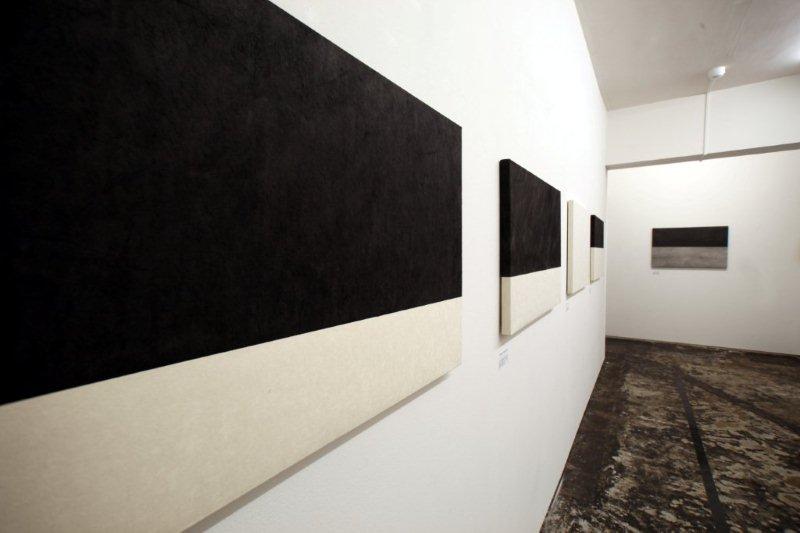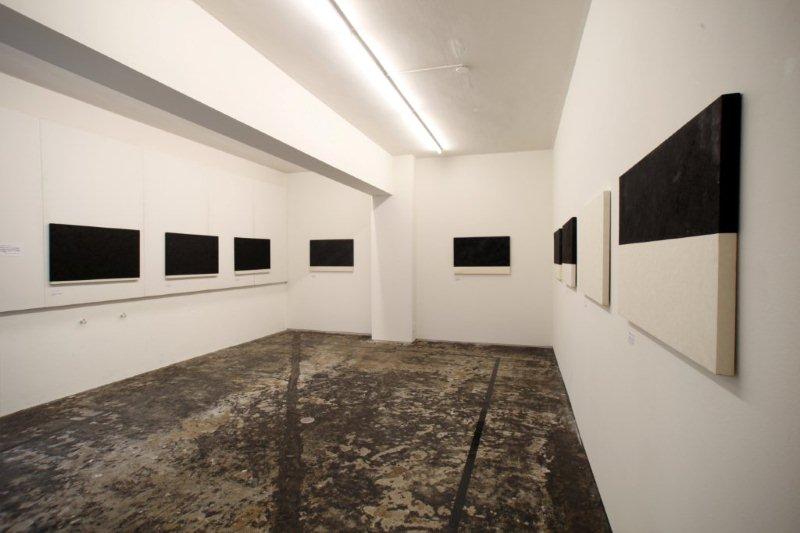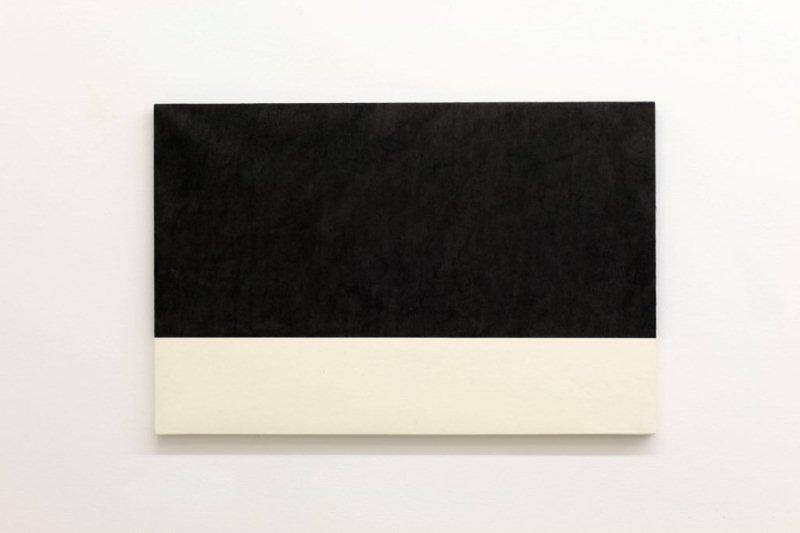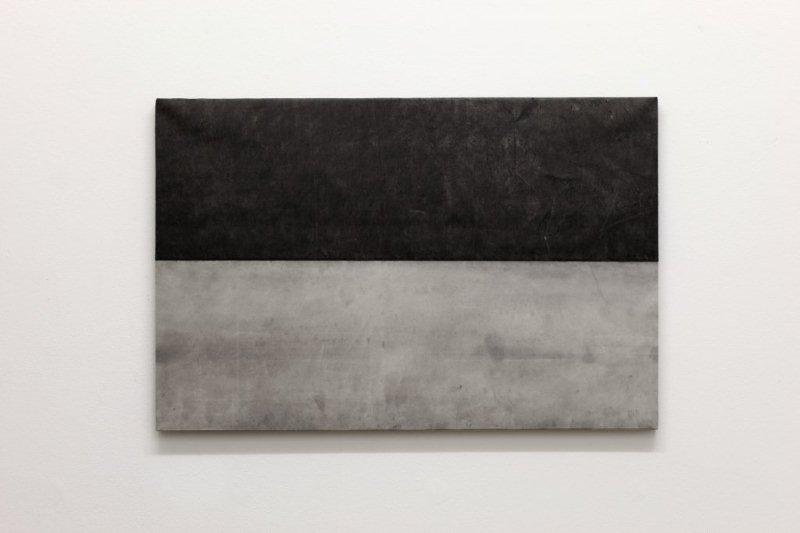藤原志保 Line ― 十牛へのプロローグ― 2015.10.16-26 Gallery 301
Shiho Fujiwara: Solo Exhibition On Line:Prologue to the Ten Bulls




藤原志保 Line ― 十牛へのプロローグ― 2015.10.16-26 Gallery 301
Shiho Fujiwara: Solo Exhibition On Line:Prologue to the Ten Bulls




Line −十牛へのプロローグ− に寄せて
越智裕二郎(評論家、西宮市大谷記念美術館館長)
「十牛」とは仏性を求める修行過程を身近な牛に例えて、その牛を飼い馴らし更にまた牛にとらわれなくなる境地までを十図に表したもの。北宋の末、中国の郭(かく)庵師(あんし)遠(おん)禅師が作ったものが著名で、それにはそれぞれの絵と頌が付き、法孫になる慈恩和尚が序文をつけて出版した。日本にも到来し室町時代以降、この十牛図は広く普及し、図は伝周文のものが知られる。
1981年藤原志保が個展を神戸で開いていた折、当時神戸の祥福寺僧堂師家であった河野太通老師が来臨、「暗雲図」を所望されたという。そこで女史が祥福寺に納めにいったところ老師から「十牛図」の話を伺い、以後ずっと女史の心に澱のように残っていた由。此の度、発念してその十牛に挑んだのが本作である。
「十牛図」には名が付いており、尋牛、見跡、見牛、得牛、牧牛、騎牛帰家、忘牛存人(ぼうぎゅうぞんにん)と続き、第八、九、十図は「人牛倶忘(にんぎゅうぐぼう)」「返本還源(へんぽんげんげん)」「入?(にってん)垂手(すいしゅ)」という。女史はこの八、九、十図の意味するところについて疑を生じ、直々に河野太通老師に伺わんとした。それを聞きつけた私は、その法縁に連ならんと同道させていただいた。老師現在網干の龍(りょう)門寺の住職を務められておられる故、一日(いちじつ)、女史とともに同寺へ赴いた。
龍門寺は播磨の生んだ江戸初期の名僧、盤珪(ばんけい)国師の根本道場なる巨寺、その創建は1661(寛文元)年といい、その風格を今も遺す。堂宇をはじめ姫路市指定文化財も多い。「不生(ふしょう)禅」を生涯にわたり説き、民衆に禅のこころ平明に語った人である。
老大師は女史の突撃インタヴューに対して正座する我々に椅子席を勧め、じっくりと禅門にとってはこの第八、九、十図が大事と、平明な言葉、比喩を用いて説いて下さった。即ち禅門の悟りとは見性であり、自己の本来の面目、仏性を見出すことである。一旦突き抜けて悟りを得ても無功徳というべきものであり(それを武帝と達磨とも問答の比喩から話された)、それに捉われることなく「花は紅松は緑」の境地に至り、そしてまた社会、市井に入って社会のために働くことが肝要だ。それをあらわしたのが「十牛図」、ことに第八、九、十図であると。また「佛に逢(お)うては佛を殺し、祖に逢うては祖を殺す」という言葉の誤用を戒められていたのが印象的であった。
この「十牛図」については、53歳で祥福寺根本道場の師家になった山田無文老師が根本道場の雲水たちに最初に提唱した由、その雲水たちに若き河野太通老師もいたという。この時の提唱は文字に起こされ、本にされている(花園大学、禅文化研究所より)。山田無文老師の謦咳(けいがい)に接するが如き善本ゆえ、ご一読を諸氏にお薦めしたい。
さて、女史の「十牛」はいかがであろうか。第八図「人牛倶忘」は通常円相であらわされるが、女史の図でもこれだけはモノトーンとなっている。第十図「「入?垂手」」は通常杖を持った布袋さまで示される。入?(にってん)とは賑わう店のある町へ赴くの意。それぞれの絵からは女史の境地、進境が問われることになろう。只「見よ見よ」である。
On Line: Prologue to the Ten Bulls
Yujiro Ochi
(Art Critic / Director, Otani Memorial Art Museum, Nishinomiya City)
The term "ten bulls" in the exhibition title refers to a set of ten
pictures illustrating a process that begins with someone taming a bull and
continues until he reaches a state in which he is free of it. Here, the
familiar animal is used as a metaphor for the aesthetic practice required to
attain Buddha nature. Known as The Ten Ox-herding Pictures, a version by the
Chinese Zen master Kuo'an Shiyuan (郭庵師遠) consisting of pictures and
verses, and an introduction by the Buddhist disciple Jion Osho (慈恩和尚) was published at the end of the Northern Song Dynasty
(12th century). After the book was first transmitted to Japan in the Muromachi
Period (1338-1573), the pictures spread throughout the country, and a version
attributed to Shubun became particularly well known.
When Shiho Fujiwara held a solo exhibition in Kobe in 1981, Taitsu Kono Roshi (河野太通老師), then head priest of Shofuku-ji Temple, paid a visit to
the show and acquired her work Dark Clouds. This prompted Fujiwara to ask the
Roshi about The Ten Ox-herding Pictures which are housed in the temple. This
conversation stayed with her for many years.
Each of the ten pictures has a title. The first seven are "In Search of
the Bull," "Discovery of the Footprints," "Perceiving the
Bull," "Catching the Bull," "Taming the Bull,"
"Riding the Bull Home," and "The Bull Transcended." The
last three are "Both Bull and Self Transcended," "Reaching the
Source," and "Return to Society." Fujiwara had some questions
about these last three, so she was planning to confer directly with Taitsu Kono
Roshi. After hearing this, I asked to accompany her on this trip to gain some
insight into Buddhism. As the Roshi is currently head of Ryumon-ji Temple in
Aboshi (Himeji city), we went to see him there one day.
Ryumon-ji is a huge temple. It served as the main dojo of the distinguished
priest Bankei Kokushi (盤珪国師), who was born in the early Edo
Period in Harima. It is believed to have been built in 1611 and has retained
its original form. The temple compound includes many Himeji Designated Cultural
Properties, including the main hall. Bankei was a man who devoted his life to
expounding on fusho Zen ("unborn Zen" - the Buddha mind without
beginning, end or any limitation) using plain language to convey the Zen mind
to common people.
Taitsu Kono Roshi sat in a chair and we sat on the floor with our legs folded
beneath us as Fujiwara conducted her rapid-fire interview. Using simple terms
and metaphors, he carefully explained the importance of the last three pictures
in Zen teaching. He said that the Zen concept of satori is a state of
awareness, and a way of discovering your original face and Buddha nature. But
that even if one were to break through and achieve satori, this was essentially
without merit (to explain this, he used a parable about a dialogue between Emperor
Wu and Daruma). We should not be swayed by this pursuit. Instead, we should
attempt to reach a state in which "a flower is red, a pine is
greenery." It is also vital that we return to town, and work for society.
This is the message that is expressed in The Ten Ox-herding Pictures, in
particular the last three pictures. His admonition regarding the misuse of the
precept, "If you meet the Buddha on the road, kill him. If you meet your
forefather on the road, kill him," was also very impressive.
Famous Yamada Mumon Roshi (山田無文老師) first advocated the use of The
Ten Ox-herding Pictures to monks in training at Shofuku-ji after he became a
Zen master at the temple at the age of 53. Taitsu Kono Roshi was among the
young men who were there at the time. Yamada's proposals have also been
transcribed and turned into a book ""(published by the Institute for
Zen Studies at Hanazono University). I recommend this excellent volume, which
is like having the honor of actually meeting Yamada Mumon Roshi.
In the end, how did Fujiwara's "ten bulls" turn out? The eighth
picture, "Both Bull and Self Transcended," is generally depicted with
a circle. In Fujiwara's version, it is the only monotone picture in the set.
The final picture, "Return to Society," usually shows Hotei (the god
of happiness) holding a staff. Each of the pictures conveys a sense of the
artist's current state and progress. With this in mind, just look!
English translation by Christopher Stephens